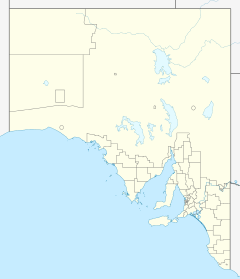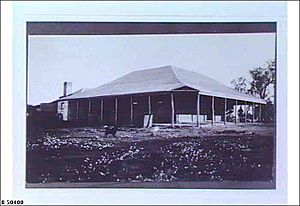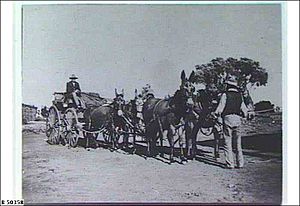Mount Eba Station facts for kids
Mount Eba Station is a very large sheep farm in the remote outback of South Australia. It's a place where sheep are raised for their wool and meat.
This station is located about 125 kilometers (78 miles) northwest of Roxby Downs. It is also about 158 kilometers (98 miles) southeast of Coober Pedy. Mount Eba Station is next to other large properties. These include Millers Creek Station to the north and The Twins Station to the west. It also borders Bon Bon Reserve to the south and Parakylia Station to the east.
The station gets its name from a single hill that stands out. This hill rises about 122 meters (400 feet) from the flat land around it. The plains are mostly covered with mulga trees and saltbush plants. You can also find dry, flat areas called salt pans scattered across the land. Today, Mount Eba Station covers a huge area of about 3,380 square kilometers (1,305 square miles).
Contents
History of Mount Eba Station
Early Days and Growth
Mount Eba Station was started in 1874 by a person named Price Maurice. Back then, it was even bigger, covering about 14,349 square kilometers (5,538 square miles). The area was very isolated and did not get much rain.
Even with these challenges, Maurice worked hard to develop the station. He dug 83 wells, and 36 of them provided good water. Between 1878 and 1880, many improvements were made. New buildings were built, and a new woolshed was completed. A woolshed is a large building where sheep are shorn and their wool is prepared.
In 1879, a lot of people worked at Mount Eba, between 80 and 100 men. By 1884, the station had many animals. It was home to 18,500 sheep, 750 cattle, and 270 horses.
Changes Over Time
By 1901, many large farms in the area, including Mount Eba, were left empty. Only a caretaker stayed behind. At this time, the property was about 4,921 square kilometers (1,900 square miles). By 1908, its size had shrunk to about 1,632 square kilometers (630 square miles). It was then home to about 5,000 sheep.
In 1914, James Gemmel was in charge of the station. He was clever and used a motor to power his windmills. This helped him get enough water for his sheep.
After World War I, the Jacob brothers took over Mount Eba before 1923. The property was about 7,770 square kilometers (3,000 square miles) then. They mostly raised cattle but planned to switch back to raising sheep. The station also included the Boolgunnia and The Twins farms.
Later Years and Challenges
In 1939, Grant Matheson was the manager and part-owner. He later joined the RAAF (Royal Australian Air Force) during World War II. He was a squadron leader. Matheson still owned the property in 1945.
The station faced a very difficult drought from 1940 to 1944. A drought is a long period with very little rain. Thousands of sheep died during this time. By 1947, H.R. Crombie was managing Mount Eba. Its size had been reduced again, from over 5,180 square kilometers (2,000 square miles) to 2,201 square kilometers (850 square miles).
In the 1950s, when the Crombie family owned it, Mount Eba was like a small town. Many staff worked there for the Woomera Rocket Range. There were also about thirty station-hands, housekeeping staff, and a bookkeeper.
The Nitschke family bought the property in 1979. They also owned the nearby Millers Creek Station. In 1994, part of the Millers Creek land was added to Mount Eba.
By 2007, a mining project called Prominent Hill started nearby. Parts of the station had to remove their animals because of this. In 2014, Mount Eba Station was put up for sale. At that time, it had 11,000 merino sheep and 300 cattle. Mount Eba was the last property owned by the Nitschke family to be sold.
In April 2013, the land where Mount Eba Station is located officially became known as a locality called 'Mount Eba'.




